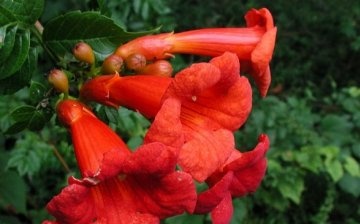Campsis in the photo: in the wild and in the garden
Campsis in the photo does not only grow in the tropics. The hummingbird's favorite plant feels great in the climate of the Black Sea coast of the Caucasus, where this vine adorns gazebos and hedges, growing in open ground.
Tiny hummingbirds are the only natural pollinator of Kampsis, as the flower shape with deep inflorescence makes it impossible for other birds to collect nectar and pollinate it.
The campsis in the photo is very decorative, but its extreme thermophilicity does not allow it to be widely used in regions with a cold climate. Campsis blooms profusely in mild climates; more severe conditions require shelter for the winter.
One of the important advantages of Kampsis is its resistance to unfavorable urban conditions, gas pollution and smoke.
Kampsis flowers are quite melliferous, but not all plants bear fruit. This, apparently, is due to the phenomenon of possible self-sterility of Kampsis, that is, its fruits are not tied if there was pollination with its own pollen. For this, another representative of the plant must grow nearby.
Kampsis fruits are formed in the form of pods 7-10 cm long and crack when ripe, spreading around themselves a lot of flat dry seeds that have a pterygoid outgrowth for good volatility. Even the slightest gust of wind carries Kampsis seeds over considerable distances.
In Russia, this vine is used for vertical gardening of facades and fences of houses, it is grown in the form of a small tree. Campsis, like most vines, tolerates pruning well, which makes it possible to give it a wide variety of shapes.






